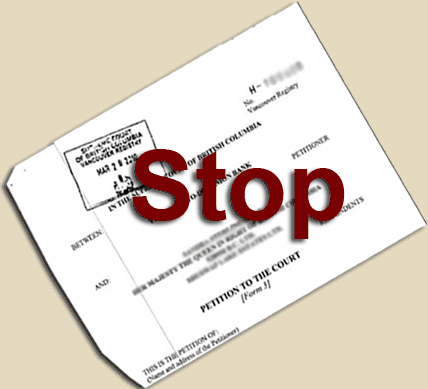The foreclosure process in British Columbia is controlled by the BC Supreme Court. What it means to the home owners is that each step of the foreclosure process has to be approved by the Supreme Court including when to start selling, the purchase price, the terms of sale, and any commission paid.
Following are the main steps of the foreclosure process as I understand them:
- If you stop paying the mortgage, you will initially get a letter from the bank or maybe even a phone call. The bank is making sure this is not a simple error of some sort and is giving you a little while to fix the problem.
- After 2~3 months you will receive a letter from the bank asking you to pay the arrears in full before a certain date and informing you that a lawyer will be hired to start foreclosure proceedings if you do not.
- If you do not pay the arrears as required, the lender will ask a lawyer to start the foreclosure process. You will receive a letter from the lawyer demanding you to either pay the full amount owing on the mortgage or only the arrears. You be given a deadline after which the foreclosure process will start.
- The first step in the foreclosure process is for the lawyer to file a document named “foreclosure petition”. Within few days after the petition is filed in the court you will be served with a copy. The petition is being sent to all interested parties including other mortgage holders, tenants in the property, other lien holders etc.
Make sure you read the petition and follow the instruction of how to file a response to the petition - About a month later there will be the first hearing in the court. At the hearing the judge will give the lender an “order nisi”, and in most cases, it will also give you time to “redeem” the mortgage by paying the full amount you owe, plus interest, costs and taxes. This time is called the “redemption period” and it’s usually 6 months. But sometimes the lender will ask the court for a shorter redemption period.
- Following the redemption period of typically six months, the lender may choose to have the property listed for sale by the court or seek an “Absolute Order of Foreclosure” from the court.
- In the case of the property being listed for sale by the court, the court approves the sale of the property. If the sale does not generate sufficient money to pay the petitioner in full, the petitioner can then seek a deficiency judgment from the court against the borrower.
- In the case where an Absolute Order of Foreclosure is granted the petitioner becomes the new registered owner of the property and all other respondents are removed from the title. Once this order has been given by the court, no further action can be taken against the borrower, These Absolute Orders of Foreclosure take place only if the property value equals or exceeds the debt, and the borrower has no assets to apply toward any deficiency.
The most important thing you have to understand as a home owner is that you do have some time to fix the problem BUT that it is in your best interest to stop the foreclosure process as quick as possible. If you feel that you are being treated unfairly by the lender, you should get legal advice. Otherwise, you should focus your efforts on stopping the foreclosure by finding a reasonable solution.
